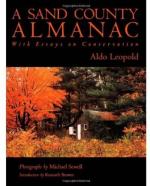
|
| Name: _________________________ | Period: ___________________ |
This test consists of 15 multiple choice questions and 5 short answer questions.
Multiple Choice Questions
1. The narrator says that geese make these migratory journeys where?
(a) Only in the western hemisphere.
(b) Only in the eastern hemisphere.
(c) Throughout the world.
(d) Only in the United States.
2. What animal do the cured oak leaves feed?
(a) Coons.
(b) Chickadees.
(c) Wood ducks.
(d) Grouse.
3. How does the painting, that the narrator describes in August, begin?
(a) With a green line.
(b) With an outline.
(c) With a silt ribbon.
(d) With the sky.
4. When is the best time to hunt for grouse?
(a) When the tamaracks turn gold.
(b) When the rain starts.
(c) When the berries turn ripe.
(d) When the weather turns cold.
5. Where is the best place to place a trap for a chickadee?
(a) Near a fallen tree.
(b) On the ground.
(c) In the tree.
(d) In the direction of the wind.
6. How long do the blackberry bushes glow red?
(a) A week.
(b) A day.
(c) One month.
(d) Two weeks.
7. Who paints the picture or scene that the narrator likes to view?
(a) The river.
(b) The painter who lives on the land.
(c) The narrator himself.
(d) The visiting painter.
8. Where do the animals go when they are pushed out of their home by the floods?
(a) Higher land.
(b) The forest.
(c) Nowhere, they drown.
(d) The prairie.
9. The narrator says that November is the month of the what?
(a) The axe.
(b) The wind.
(c) The tractor.
(d) The shovel.
10. Where does the narrator go to see silphium?
(a) The graveyard.
(b) The field.
(c) The forest.
(d) The riverbank.
11. People tend to ignore song birds that do what?
(a) Sing long songs.
(b) Sing only in the evening.
(c) Sing only part of the time.
(d) Sing all the time.
12. Why does the narrator love the aspen?
(a) It has beautiful leaves.
(b) It has lovely colors.
(c) It provides food for his grouse.
(d) It grows tall.
13. How many acres of land does the narrator legally own?
(a) 120.
(b) 12.
(c) 100.
(d) 50.
14. What tree does the narrator have a bias towards?
(a) Pine.
(b) Birch.
(c) Oak.
(d) Willow.
15. What do people follow, since there is so little going on in nature in January?
(a) Bird migrations.
(b) Animal tracks.
(c) Bird nestings.
(d) Plant growth.
Short Answer Questions
1. Most geese travel in families of how many?
2. What or who kills the oak tree?
3. A person tells a lot about animals' feeding habits during a season by looking at what?
4. Why don't people ignore all these wild plants?
5. Getting up early is a vice of horned owls, stars, geese and what?
|
This section contains 415 words (approx. 2 pages at 300 words per page) |

|




